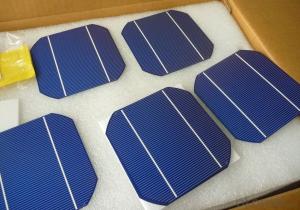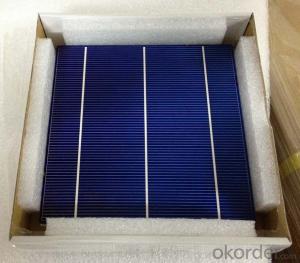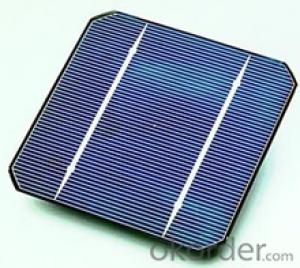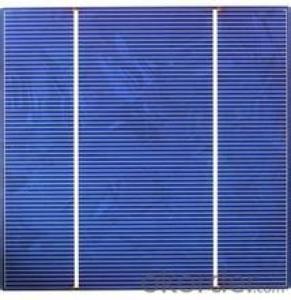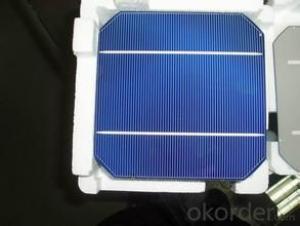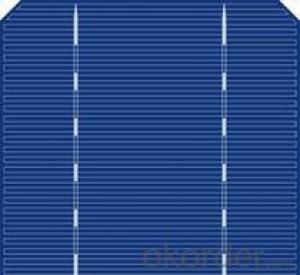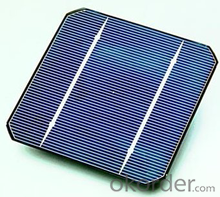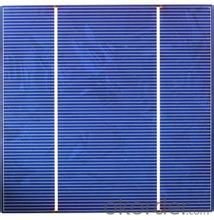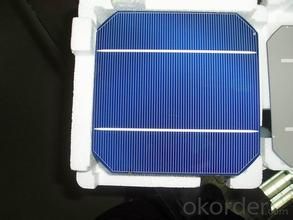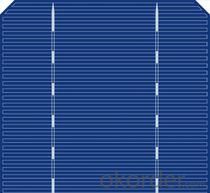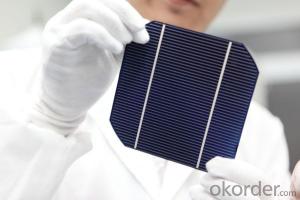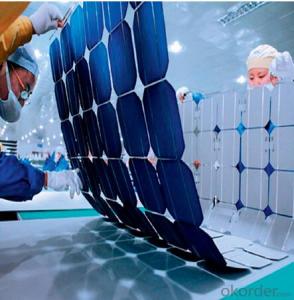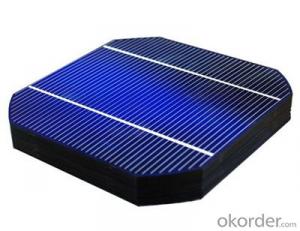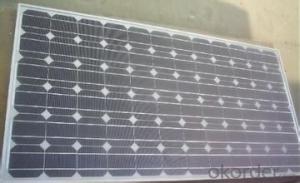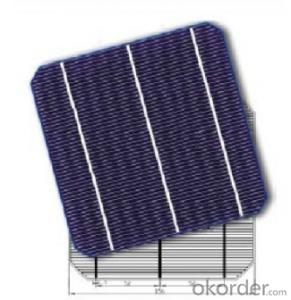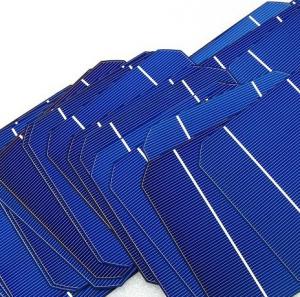Solar Cells for Boats - Monocrystalline Silicon Solar Cells 156mm (14.00%-17.25%)
- Loading Port:
- Shanghai
- Payment Terms:
- TT OR LC
- Min Order Qty:
- 1000 watt
- Supply Capability:
- 100000000 watt/month
OKorder Service Pledge
OKorder Financial Service
You Might Also Like
Specification
1.Description of the Solar Cells
Monocrytalline Silicon Solar Cells 156mm (14.00%----17.25%)
We supply regular mono 125x125mm and poly 156x156mm solar cells.
Cells made in China mainland and Taiwan are both available.
Cell production capacity yearly reach 1GW.
Our cells pattern include continuous and uncontinuous busbar to meet different cells line.
2.Mechanical data and design of the Solar Cells
| Format | 156 mm × 156 mm ± 0.5 mm |
| Thickness- | 210 μm ± 40 μm |
| Front (-) | 1.5 mm bus bars (silver),blue anti-reflection coating (silicon nitride) |
| Back (+) | 2.5 mm wide soldering pads (silver) back surface field (aluminium) |
3. Temperature Coefficient of the Solar Cells
| Voc. Temp .coef.%/K | -0.351%/K |
| Isc . Temp .coef.%/K | +0.035%/K |
| Pm. Temp. coef.%/K | -0.47%/K |
4.Electrical Characteristic of the Solar Cells
Efficiency (%) | Pmpp (W) | Umpp (V) | Impp (A) | Uoc (V) | Isc (A) | FF (%) | ||
17.25 | 4.197 | 0.524 | 7.992 | 0.62 | 8.458 | 80.03% | ||
17 | 4.137 | 0.524 | 7.876 | 0.619 | 8.353 | 80.01% | ||
16.75 | 4.076 | 0.522 | 7.81 | 0.617 | 8.286 | 79.73% | ||
16.5 | 4.015 | 0.518 | 7.746 | 0.613 | 8.215 | 79.73% | ||
16.25 | 3.955 | 0.515 | 7.683 | 0.61 | 8.144 | 79.61% | ||
16 | 3.894 | 0.512 | 7.613 | 0.608 | 8.075 | 79.31% | ||
15.75 | 3.833 | 0.51 | 7.534 | 0.605 | 8.058 | 78.62% | ||
15.5 | 3.772 | 0.508 | 7.453 | 0.604 | 8.02 | 77.87% | ||
15.25 | 3.711 | 0.505 | 7.35 | 0.604 | 7.997 | 76.83% | ||
15 | 3.65 | 0.503 | 7.271 | 0.604 | 7.989 | 75.64% | ||
14.5 | 3.529 | 0.499 | 7.067 | 0.604 | 7.988 | 73.14% | ||
14 | 3.407 | 0.499 | 6.833 | 0.604 | 7.833 | 72.01% | ||
5.Intensity Dependence of the Solar Cells
Intensity [W/m2] | sc× [mA] | Voc× [mV] |
1000 | 1.00 | 1.000 |
900 | 0.90 | 0.989 |
500 | 0.50 | 0.963 |
300 | 0.30 | 0.939 |
200 | 0.20 | 0.920 |
6.Applications of the Solar Cells
electric power generation
7.IMages of the Solar Cells

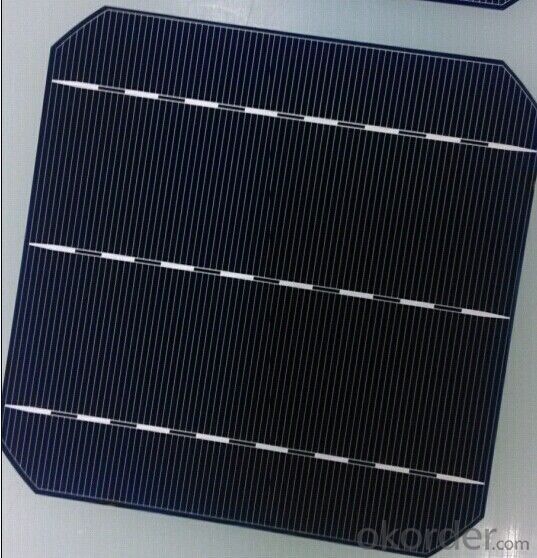

FAQ
- Q: How do solar cells handle voltage fluctuations in the grid?
- Solar cells do not directly handle voltage fluctuations in the grid. However, they can contribute to stabilizing the grid by generating electricity from sunlight, which helps balance the supply-demand equation. To manage voltage fluctuations, grid operators use various methods such as energy storage systems, inverters, and smart grid technologies that can regulate and control the flow of electricity in the grid.
- Q: Can I trust the suppliers for film solar that I found on alibaba ?
- I have been doing business on alibaba for over 10 years, and I seldom came across the unreliable suppliers from alibaba . Therefore, I should say I do trust the suppliers I found.
- Q: Briefly explain why solar cells are made into components
- The main photovoltaic material is the crystalline silicon material (including polysilicon and monocrystalline silicon), this material is high hardness, brittleness, uneven force easily brittle, exposed to the air easily oxidized, and the use of the process can not
- Q: Can solar cells be used in data centers or server farms?
- Yes, solar cells can be used in data centers or server farms. They can be installed on the rooftops or surrounding areas of these facilities to harness solar energy and convert it into electricity. This renewable energy source can help offset the power consumption of data centers and server farms, reducing their carbon footprint and reliance on traditional energy sources.
- Q: How do solar cells perform in extreme weather conditions?
- Solar cells generally perform well in extreme weather conditions, but their efficiency can be affected to some extent. In extremely hot conditions, solar cells may experience a decrease in efficiency due to increased thermal losses and a decrease in voltage output. Similarly, in extremely cold conditions, solar cells may also experience reduced efficiency due to decreased sunlight absorption and increased resistance. However, modern solar cell technologies are designed to withstand a wide range of weather conditions and have protective coatings to ensure their durability. Overall, while extreme weather conditions can have some impact on solar cell performance, they still remain a viable and reliable source of renewable energy.
- Q: Can solar cells be used in telecommunications infrastructure?
- Yes, solar cells can be used in telecommunications infrastructure. They can be used to power various equipment such as base stations, repeaters, and remote monitoring systems. Solar power provides a reliable and sustainable energy source that can be utilized in remote or off-grid locations, reducing dependence on traditional power sources and lowering operational costs. Additionally, solar cells have a longer lifespan and require minimal maintenance, making them an ideal option for powering telecommunications infrastructure.
- Q: How long does it take to make a solar cell?
- It is now mass produced, so it doesn't take long to make it in the factory.
- Q: How do solar cells impact carbon emissions?
- Solar cells have a significant impact on carbon emissions as they generate electricity from the sun's energy, reducing the need for fossil fuel-based power generation. This clean and renewable energy source helps to decrease carbon dioxide emissions, mitigating climate change and promoting sustainable development.
- Q: Can solar cells be used in electric fence systems?
- Yes, solar cells can be used in electric fence systems. Solar cells convert sunlight into electricity, which can be used to power the electric fence. This eliminates the need for traditional power sources such as batteries or connecting to the electrical grid, making it a more sustainable and cost-effective option.
- Q: What materials are commonly used to make solar cells?
- Silicon is the most commonly used material for making solar cells. Other materials, such as cadmium telluride, copper indium gallium selenide, and perovskite, are also used in certain types of solar cells.
Send your message to us
Solar Cells for Boats - Monocrystalline Silicon Solar Cells 156mm (14.00%-17.25%)
- Loading Port:
- Shanghai
- Payment Terms:
- TT OR LC
- Min Order Qty:
- 1000 watt
- Supply Capability:
- 100000000 watt/month
OKorder Service Pledge
OKorder Financial Service
Similar products
Hot products
Hot Searches
Related keywords
